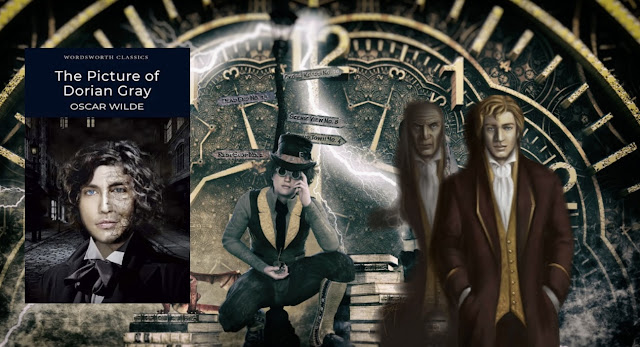1890: Wilde’s Bewitching Dance Between Beauty and Corruption. In Oscar Wilde's timeless masterpiece, "The Picture of Dorian Gray," he weaves a gothic tale that explores the intricate relationship between beauty, morality, and the depths of human nature. Set against the backdrop of the vibrant and decadent society of late 19th-century London, this haunting novel immerses readers in a world where art, desire, and the pursuit of eternal youth converge.
At the heart of the story is the enigmatic Dorian Gray, a young man whose striking beauty captures the attention of artist Basil Hallward. When Basil paints a portrait that seems to encapsulate Dorian's youthful allure and inner essence, an uncanny twist of fate unfolds. As Dorian embarks on a hedonistic journey, indulging in every pleasure and vice without consequence, the portrait ages and reveals the true nature of his soul.
Wilde's prose is filled with wit and intellect, coloured with descriptions that transport readers to the opulent salons and shadowy corners of Victorian society. Through his masterful storytelling, he delves into themes of aestheticism, moral decay, and the pursuit of an idealized version of oneself. The characters that orbit Dorian—Basil, the earnest artist, and Lord Henry Wotton, the captivating embodiment of decadence—add depth and complexity to the narrative, contrasting the forces that shape Dorian's transformation.
"The Picture of Dorian Gray" challenges societal norms and raises profound questions about the nature of art, beauty, and the consequences of unchecked desire. It is a cautionary tale that holds a mirror to our own obsessions and invites us to contemplate the dualities that reside within us all.
2002: Self’s Bold and Provocative Reworking of Wilde's Classic. Will Self's daring and controversial novel, "Dorian," presents a mesmerizing and thought-provoking reimagining of Oscar Wilde's timeless tale, "The Picture of Dorian Gray." In this modern adaptation, Self skillfully captures the essence of Wilde's original while infusing it with his distinctive style and social commentary.
Set in the vibrant and frenetic world of 1980s London, "Dorian" transports readers into a world of excess, narcissism, and self-destruction. Self's prose is sharp and unapologetic, reflecting the hedonistic atmosphere of the era. He delves deep into the psyche of his characters, particularly Dorian, who becomes an emblematic figure of the AIDS epidemic and its impact on society.
Self's exploration of the theme of vanity and the destructive pursuit of youth and beauty resonates powerfully in this adaptation. Through vivid descriptions and introspective narrative, he navigates the dark corners of Dorian's mind, exposing the consequences of his indulgences.
While Self's "Dorian" is a captivating and audacious retelling, it may not appeal to purists of Wilde's original work. It takes risks, challenging traditional interpretations and offering a modern lens through which to view the story. Readers familiar with Wilde's novel will find intriguing parallels and departures, prompting them to question societal values and the notion of eternal youth in contemporary culture.
Film Adaptations. Oscar Wilde's "The Picture of Dorian Gray" has captivated filmmakers for decades. The most notable adaptation is the 1945 film directed by Albert Lewin, starring Hurd Hatfield as Dorian Gray. This classic interpretation preserves the essence of Wilde's novel, capturing the decadence and moral dilemmas at its core. The haunting portrait of Dorian Gray, aging while he remains eternally youthful, serves as a striking visual metaphor throughout the film.
Other adaptations, such as the 2009 film directed by Oliver Parker and the 2019 film "Dorian Gray" directed by Michael Matteo Rossi, offer their own unique interpretations of the story. Each adaptation brings its own visual flair and narrative choices, exploring different facets of Dorian's descent into corruption.
A Timeless Tales' Adaptation: Gray’s Realm. Book and film adaptations serve as compelling additions to the legacy of Wilde's masterpiece, offering fresh perspectives and inviting audiences to engage with the timeless themes that continue to resonate in our contemporary world.
We’re considering making Oscar Wilde's timeless masterpiece our next adaptation. In our adaptation, “Gray’s Realm”, the metaphor of a painting could be updated, transcending the limitations of a mere canvas. As Dorian navigates the tumultuous waters of vanity, temptation, and self-obsession, he becomes entangled in a web of groundbreaking technologies that redefine his perception of self. Rather than a physical portrait, Dorian's identity is intricately linked to neural implant technology.
The combination of immersive virtual reality, augmented reality and neuro-technological advancements, turns Dorian's world into a playground of hyper-realistic experiences and mind-altering simulations. Could a rogue neural implant provide an illusory window into his soul, projecting vivid representations of his moral choices, desires, and hidden secrets?
Technological visual representation brings a fresh dimension to the story, illuminating the destructive impact of vanity and moral corruption in an era defined by technological advancements.
Ethical implications of merging humanity with technology would be addressed. What are the consequences of embracing artificial intelligence and implants as extensions of our identity? Can we have boundaries in an era of limitless possibilities? This groundbreaking interpretation would breathe new life into Wilde's timeless tale, paving the way for an immersive experience that examines the intricate relationship between humanity, technology, and the eternal pursuit of perfection.
